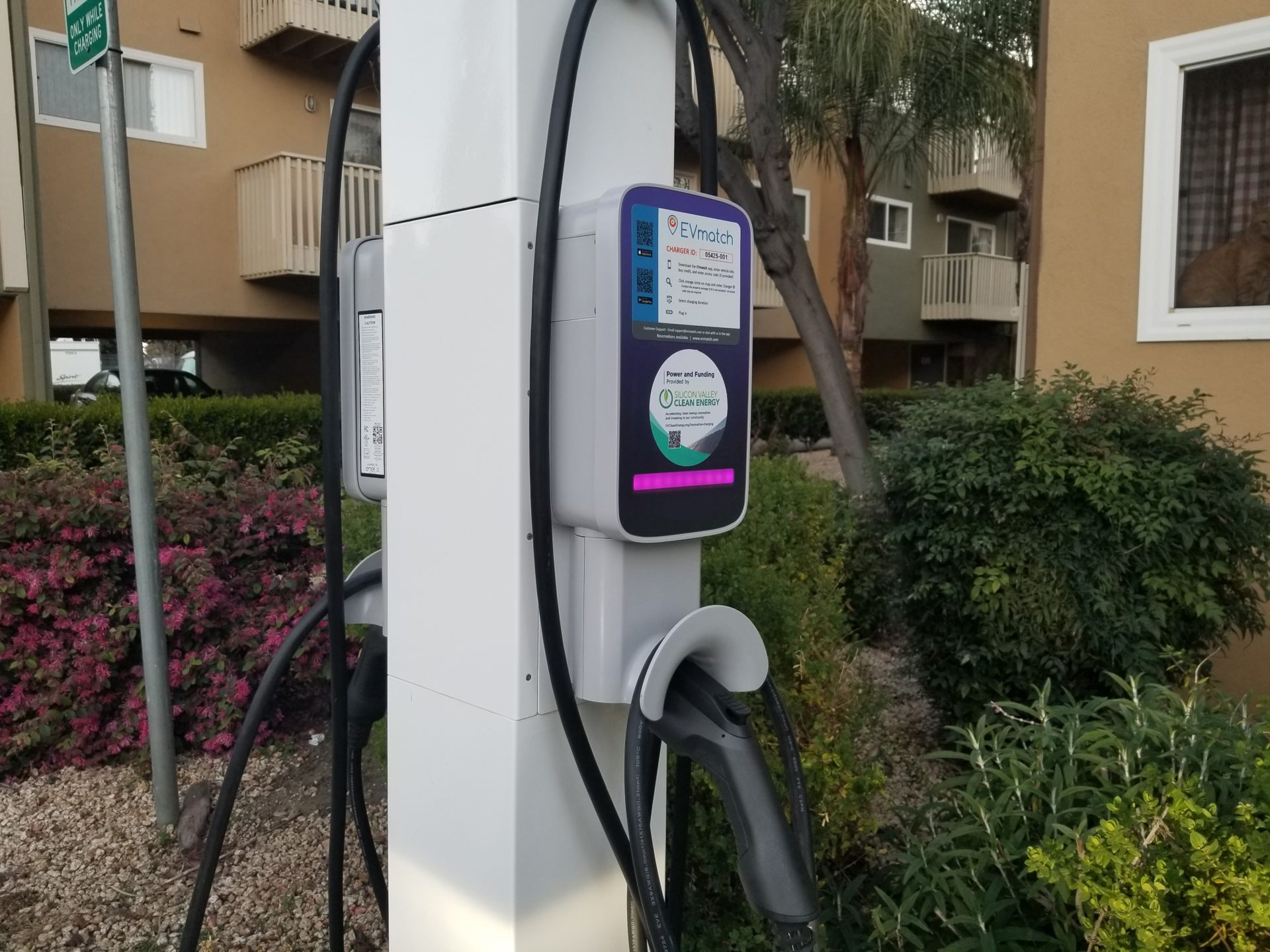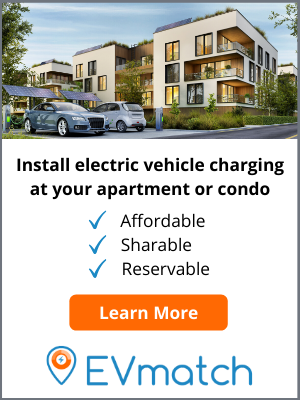Blog
How to Add EV Charging to an Apartment or Condo
October 31, 2022
Post Author

Charging an electric vehicle (EV) is most convenient at home overnight, however, those who rent may find a challenge getting EV charging installed. Through a series of steps, it can be done and EVmatch will help throughout the whole process! Here’s a guide from A-Z on how to add charging at an apartment or condominium.
According to the Pew Research Center, in 2019 approximately 36% of the United States population was renters. Property management companies, homeowner associations (HOAs), and landlords initially may be unfamiliar or uninterested in installing EV chargers for their tenants. Since charging an EV at home overnight is both the most convenient and cost-effective way to go, renters who have or who are looking into getting an EV have a hurdle to overcome. With a little education (discussed later), property owners are often persuaded to approve the project as it benefits them as well!
10 Steps to Getting EV Charging as a Renter
While the overall project may seem daunting at first, when broken down into smaller segments it is actually fairly straightforward. There are just 10 steps to navigate through in order to get EV charging at apartments or condominiums. Here’s how:
Step 1: Receive Owner or Board Approval
Renters and condo owners are typically not allowed to make any permanent modifications to the rental or condo property without prior owner or HOA board approval. The first step in this process is to receive consent from the property owner or board. Property owners will likely have a number of questions such as:
- How much does it cost?
- How many tenants have an EV/want EV charging?
- Who pays for the electricity?
- Where will it be installed?
- Is it available only to tenants or also to the public?
- Are there rebates available to cover a portion of the cost?
- How does this benefit the property owner?
Many of these questions can be answered now with a little research online ahead of time. Feel free to check out the EVmatch whitepaper on this topic. It covers a lot of these questions in further detail and can be downloaded for free.
Other questions can be addressed later in the project when more information becomes available, or an electrical contractor has been engaged. The most important thing during this step is to ensure all of the owner’s questions will be answered prior to incurring any substantial project costs.
In most cases, the owner will be interested in the project pending a few answers to their questions. They may form a committee or assign a delegate to investigate the project further.
Step 2: Evaluate Demand
Next, it is important to evaluate how many tenants want EV charging. You may be surprised that you are not alone. Other renters may also have an EV and have been wanting EV charging at their apartment for quite some time. Additionally, you may find other renters who are interested in getting an EV but may be hesitant to purchase or lease one until they solidify their charging plan. With EV charging at their residence, they may be ready to make the purchase.
It could also be helpful to understand how many tenants are thinking about getting an EV in the coming years as the installation project can include additional capacity for future chargers. It is much more cost effective to install stub-outs for future chargers during the first project rather than to come back and re-trench and repave/repour asphalt or concrete multiples times.
For a general frame of reference, according to the Alliance for Automotive Innovation, EVs represented 6.28% of all passenger auto sales during the first half of 2022. Some EV-popular states, such as California, District of Columbia, and Washington, have an EV market share of 18.32%, 12.7%, and 10.36%, respectively. These numbers increase every year as new EV models come the market and more and more people are making the switch to electric!
Step 3: Identify Location(s)
The third step in getting EV charging when renting an apartment or condo is to identify the location(s) for the EV chargers. Some multi-family properties have shared parking, which is parking that is not assigned to any particular tenant. In this situation, EV charging is fairly easy to implement as the chargers can be conveniently located near the house electrical panel to which it will be connected. For shared-use chargers, it is important to plan charging stations for mobility impaired renters. Per local building codes and the Americans with Disabilities Act (ADA), a certain number of chargers must be accessible. It’s helpful to check early on with your local permitting agency (e.g. city or county) to learn how many ADA-compliant charging stations will be required for your project.
If parking is assigned, the chargers will need to be located at the guest parking spaces so that the chargers can be shared among all renters, or the chargers will be installed in dedicated parking stalls and can only be used by the assigned tenants. A creative option is to install chargers in between two assigned parking stalls and use the EVmatch software for efficient sharing and payments processing among two drivers.
As needed, an electrical contractor can assist with this step of siting the charging station locations.
Step 4: Assess Available Electrical Capacity
Once the location(s) are identified, the next step is to determine how much electrical capacity is available. Some properties may have extra space in the electrical panels; however, some may not be as fortunate. If an electrical service upgrade is required, it’s a good time to think about other electrification projects such as fuel-switching gas hot water heaters or gas ranges to electric versions or even installing solar photovoltaic panels. Additionally, for service upgrade projects, the electric utility may be involved.
An electrical contractor will be able to assist in the step and help determine what needs to be done in order to install the chargers. EVmatch has a network of pre-qualified and trusted electricians across the country and is glad to make a referral upon request. Reach out here if you’d like support getting connected to an electrician with experience installing EV charging stations in your area.
Step 5: Select Equipment
Selecting equipment is the next step in getting EV chargers installed. There are many different chargers on the market. Each have different features and price points. For example, some have higher power output than others, some have a retractable cable management system, and some have different warranty lengths.
As a recommendation, EVmatch prefers the Enel X Way Juicebox or the Wallbox Pulsar Plus. Not only are they reliable and affordable chargers well suited for multi-family sites, but they are also compatible with our networking/software services.
Speaking of networking, networking is required when access control, pricing schedules, charging session limits, and/or other controls are desired. Multi-family property owners typically want this type of control over the chargers. Most importantly, through networking, the cost of electricity can be passed on to the EV driver. This is especially important to property owners as they rarely want to be left with the bill to charge their tenants vehicles.
You can learn more about the EVmatch networking service here.
Step 6: Select an Electrical Contractor
You may have already done so to complete step three and four, but if you haven’t yet, now is the time to get a contractor onboard. The electrical contractor will be responsible for installing the EV chargers, completing any additional electrical work to prepare the site (i.e. getting the site “make-ready”), and repaving or repouring any disturbed asphalt or concrete.
In addition to selecting a contractor with proper licensing, it may be worthwhile to select a contractor who is Electric Vehicle Infrastructure Training Program (EVITP) certified. This certification is exclusively for installing and maintaining EV chargers and is quickly becoming the standard for such projects. Some rebate programs require that your contractor be EVITP-certified, so be sure to check rebate program requirements if you are planning to submit a local rebate application for the project.
Step 7: Apply to Rebates
There are EV charging station rebates available throughout the country. Offered by the state, local government, and/or electric utility company, these rebates can often cover 50% to 80% of project costs. Before proceeding any further, it is important to search and apply to these programs at this time. In some cases, the rebate programs may have particular requirements such as eligible equipment that should be incorporated into the project to remain complaint with the program. EVmatch has extensive experience helping clients find and apply for rebates, especially the CALeVIP program in California. Just reach out if you have questions about what your site might be eligible for!
Step 8: Submit for Permits
Nearly there! Now is the time to generate construction plans and submit an electrical permit application. The contractor will be able to complete this entire step. The property owner will likely want to review the plans and will have to sign for the permit application. Typically, permitting takes a couple of weeks depending on the jurisdiction. Once approved, the project is ready to start installation of the EV chargers!
Step 9: Begin Installation
It is finally time for the installation of the EV chargers. Depending on the scope of work and material lead times, this can take anywhere from a couple of weeks to several months. During this time there may be slight parking and electrical service interruptions. It is recommended that the contractor stay in constant contact with the property owner or management to ensure everyone is on the same page and tenants are notified in advance when on-site work or interruptions will take place. The charging station will need to be connected to a local WiFi or a cellular network after installation, which is a task typically completed by the electrician or maintenance staff.
Step 10: Begin Charging!
Once the building inspector has finaled the project and closed out the permit, it is now time to begin charging! If networked, the chargers will need to be set up for service. This step should include the property owner so they can customize the settings (such as pricing structure) as they see fit. Of course, if any adjustments to the chargers are needed after a few months of operation, the settings can be adjusted as needed.
Alternative EV Charging Options for Renters
If for some reason the property owner or management company says no to the EV charging project, do not be fully dismayed as there are still alternative options available. One alternative is to use nearby public charging stations. They are increasing in number each year and especially with the $7.5B national charging network set to begin installations in 2023. With a weekly charge (similar to fueling a gas vehicle), you can get by without having home charging. You can find nearby public charging stations via the Plugshare website and app, and reserve charging sessions in advance with the EVmatch app.
Another option is to utilize a smart splitter. This device can provide power to two different 240V devices such as an electric dryer, hot water heater, and EV charger. While this option is only available to renters who 1) have a dedicated parking space and 2) have a 240V outlet at their parking space, it can be an easy, cost-effective solution. The smart splitter simply plugs into the 240V outlet and provides two outlets for a primary and secondary device. Power is shared or sent to the device in need. Best of all, this option doesn’t require a permit or a contractor to install. However, a portable, plug-in 240V charger is required for this option. EVmatch recommends the NeoCharge Smart Splitter.
EV Charging for Apartments and Condominiums is the Latest Site Amenity in High Demand
The property owner, HOA, or management company may have hesitation about installing EV chargers at the apartment complex, however, with a little education they may be persuaded! Here are a few talking points to encourage them to approve the EV charging project:
- Brings a new, unique amenity for residents
- Shows an example of meeting residents’ requests and future needs
- Recruits EV owners searching for a community that has charging stations
- Promotes sustainability efforts and gains LEED certification points
- Supports emerging technologies and showcases your community as innovative
- Maintain competitive edge over nearby apartments and condo sites
Look to EVmatch for Your EV Charging Project
EVmatch provides software services to EV chargers, which allow EV drivers to find and charge at shared charging stations through the mobile app. Station hosts just need to complete the initial setup and then EV drivers can use the chargers on a daily basis with no added work for admin staff. Station hosts select the charging price and can even set dynamic and customized pricing as needed. Some hosts decide to simply cover the electricity costs, while others charge a slight premium to generate revenue. With EVmatch, the station host has complete control over the use of the chargers while providing an easily accessible amenity to EV-driving tenants.
You can learn more about why EVmatch may be the right choice for your multi-family housing EV charging project here.










